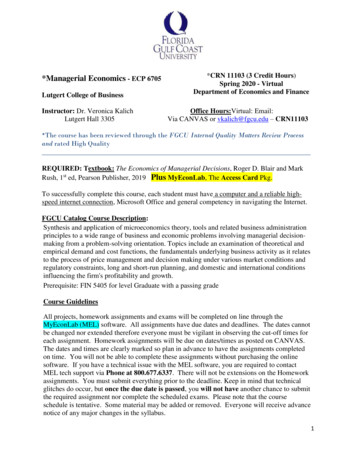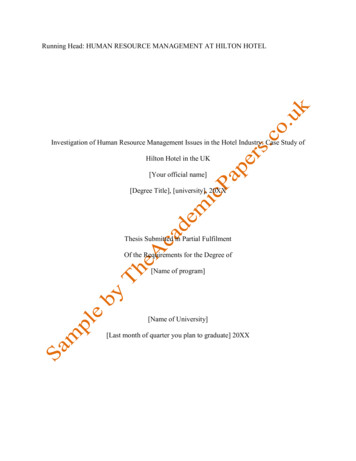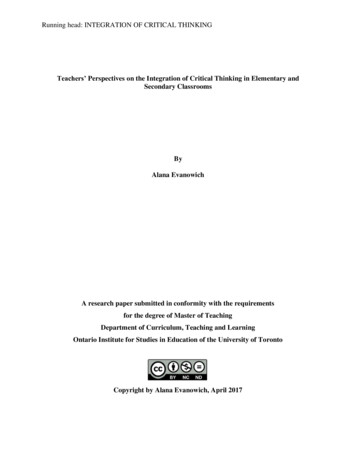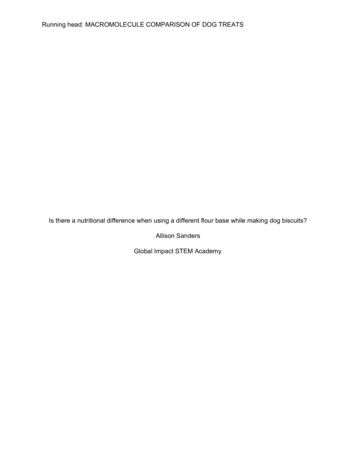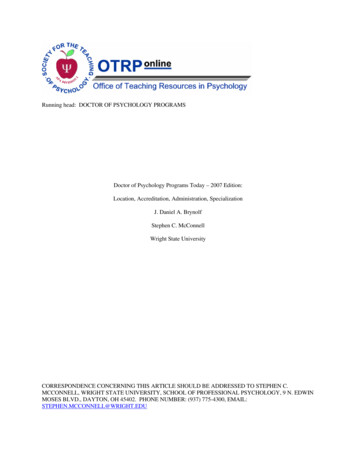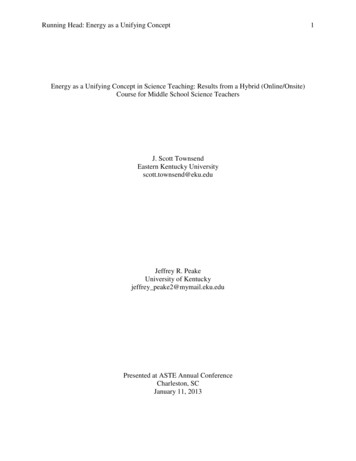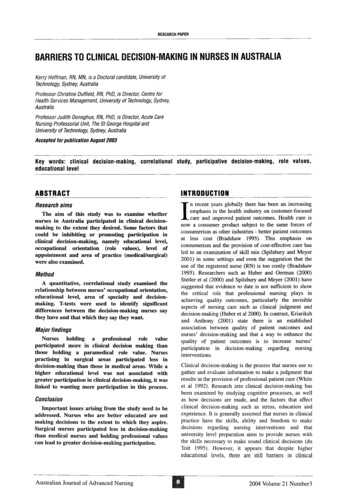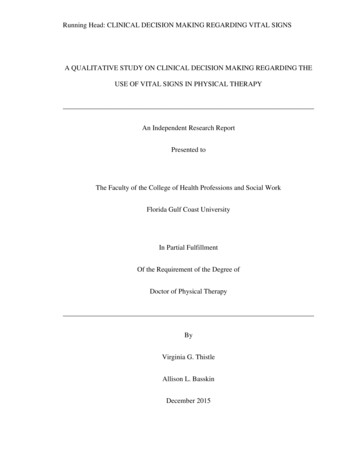
Transcription
Running Head: CLINICAL DECISION MAKING REGARDING VITAL SIGNSA QUALITATIVE STUDY ON CLINICAL DECISION MAKING REGARDING THEUSE OF VITAL SIGNS IN PHYSICAL THERAPYAn Independent Research ReportPresented toThe Faculty of the College of Health Professions and Social WorkFlorida Gulf Coast UniversityIn Partial FulfillmentOf the Requirement of the Degree ofDoctor of Physical TherapyByVirginia G. ThistleAllison L. BasskinDecember 2015
Clinical Decision Making Regarding Vital SignsAPPROVAL SHEETThis independent research is submitted in partial fulfillment ofthe requirements for the degree ofDoctor of Physical TherapyVirginia G. Thistle, SPTApproved: December 2015Allison L. Basskin, SPT, CSCSApproved: December 2015Eric Shamus, PhD, DPT, CSCSCommittee ChairRenee Jeffreys, PhD, RCEPCommittee MemberThe final copy of this independent research project has been examined by the signatories,and we find that both the content and the form meet acceptable presentation standards ofscholarly work in the above mentioned discipline.
Clinical Decision Making Regarding Vital SignsAcknowledgementsThe authors would like to thank their research committee chair, Dr. Eric Shamus,and committee member Dr. Renee Jeffreys for their feedback and support. Lastly, thankyou to the physical therapists who kindly participated in the research.
Clinical Decision Making Regarding Vital Signs1Table of ContentsAbstract 3Introduction .5Purpose .5Research Question .6Literature Review .6Methods .15Research Design and Instrumentation .15Sampling Strategy .16Data Collection .16Data Analysis .16Results . 17Decision to Take Vital Signs on the First Scenario Patient .17Decision to Take Vital Sings on the Second Scenario Patient .19Source of Reference for Cardiovascular Risk 21Clinical Experience 21Education .22Patient Presentation 22Factors Influencing Decision to Treat or Refer .23Patient History .23Clinical Experience 24Parameters . 24Contact the Physician . 25
Clinical Decision Making Regarding Vital Signs2Discussion .25Limitations .26Conclusion .27References .28Appendix A: Informed Consent Form .30Appendix B: Recruitment Script 32Appendix C: Questionnaire .33Appendix D: Participant Responses .35
Clinical Decision Making Regarding Vital Signs3AbstractIntroduction Clinical decision making is an integral component of patient care.Vital signs are a component of the clinical decision making process each visit. Theseinclude body temperature, blood pressure, heart rate, respiratory rate, and pulse oximetry.Measuring vital signs allows physical therapists to screen for red flags, monitor apatient’s cardiovascular response to exercise, and incorporate relevant information intothe plan of care. Previous studies have shown that physical therapists do not alwaysobjectively measure vital signs each visit. With physical therapists emerging asautonomous practitioners, it is important to understand which factors strongly influencethe clinical decision making of physical therapists to take vital signs.Methods Seventeen practicing physical therapists were given a questionnaire byphone, email, or in person. The questionnaire contained three sections includingdemographic data, clinical decision making questions, and two risk-based scenarios inwhich participants were asked to indicate whether or not they would assess vital signs.Results The primary factors cited in response to source of reference of assessingvital signs included clinical experience, education, and patient presentation. The primaryfactors included by physical therapists in response to the decision to treat or refer basedon abnormal vital signs included patient history, clinical experience, various parameters,and contacting the physician. Several different themes emerged with respect to clinicaldecision making that included utilizing ACSM guidelines, clinical experience,physician’s protocol, education, patient presentation, criteria proposed by thecardiopulmonary section of the APTA, and facility policies and procedures. In addition,
Clinical Decision Making Regarding Vital Signs4there did not appear to be an agreement by participants on the definition of abnormal vitalsigns seen clinically.Conclusion The variation of factors that influenced the decision making processby the participants may be reflective of the lack of guidelines and the broadunderstanding of the need and benefit of objectively assessing vital signs.
Clinical Decision Making Regarding Vital Signs5IntroductionPhysical Therapists (PT) can practice as autonomous practitioners (Domholdt &Durchholz, 1992). Measuring vital signs including temperature, blood pressure (BP),heart rate (HR), respiratory rate, and pulse oximetry (SpO2) allows physical therapists toscreen for red flags, monitor a patient’s cardiovascular response to exercise, incorporaterelevant information into the plan of care and use the information gained for makingclinical predictions. Physical therapists do not always measure vital signs every visit(Peters, 2014). Whether PTs should be measuring vital signs every visit can becontroversial, as patients’ status can undergo changes from day to day that are not visibleor easily communicated. Evaluation and treatment of many dysfunctions can commonlyinvolve physical exertion which can increase stress on the patient’s different bodysystems. Clinicians have stated that they use clinical decision making in determiningwhich vital signs they measure based on observations or patient information providedthrough risk assessment. The decision to take vital signs is a component of clinicaldecision making for PTs, which is multi-factorial in nature. Evidence on clinical decisionmaking in relation to vital signs is not widely available in the existing literature. It istherefore important to know which factors influence the decision to take vital signs.PurposeThe purpose of the study was to examine the clinical decision making processinvolved in the measurement of vital signs by physical therapists including bodytemperature, blood pressure, heart rate, respiratory rate, and pulse oximetry.
Clinical Decision Making Regarding Vital Signs6Research QuestionThis study sought to answer the question, “What factors most strongly influencethe decision of physical therapists to take vital signs?”Literature ReviewClinical Decision MakingClinical decision making is a strategy employed by clinicians which is highlyvariable and often difficult to quantify. Smith, Higgs, and Ellis (2007) examined thefactors that influenced the clinical decision making process in the acute care setting usingobservation and semi-structured interviews. Because environment can impact clinicaldecision making, the authors sought to examine the influence of a “complex, busyorganizational context” in an urgent environment in which adverse effects are highlypossible (2007). Smith et al. (2007) described clinical reasoning as a complex andmultiphasic phenomenon wherein physical therapists develop an understanding of theproblems of their patients as the basis for action. Through data analysis, the researchersfound the most influential factors for cardiorespiratory decision making included thephysical therapists themselves, the nature of the decision, and context in which thedecision occurred. In addition, the researchers reported that the more complex thedecision, the more in-depth the reasoning process was reported to be. This studyillustrates the role of subjective factors in the variable clinical decision making process.Vital Signs as a Measurement ToolVital signs can provide information that elucidates the immediate conditions ofpatients in the clinic. Moreover, monitoring vital signs continuously can help to indicatesystemic changes and assess progress. In a retrospective study which looked at 1.15
Clinical Decision Making Regarding Vital Signs7million individual vital signs from a level 1 trauma hospital, Bleyer et. al (2011) soughtto examine the association of critical vital signs during hospitalization and mortality. Theresearchers defined a critical vital sign as the level at which a patient had a 5% or greaterchance of mortality. The measures included in the study comprise systolic and diastolicblood pressure, temperature, heart rate, respiratory rate, pulse oximetry reading, level ofconsciousness, and Glasgow coma score if applicable. Of the measurements taken, theresearchers reported that the most commonly missing vital signs included temperatureand pulse oximetry. The results of the study indicate that the presence of one criticallyabnormal vital sign was associated with a mortality of .92% whereas three simultaneouscritical vital signs were associated with a mortality of 23.6%. It is interesting to note thatof those individuals who experienced three simultaneous critical vital signs, only 25% didso within the first 24 hours of admission. The implications of this study thereforehighlight the need for early recognition as well as continuous monitoring and attentionpaid to abnormal vital signs.Stanforth et. al (2000) examined the reproducibility of resting systolic anddiastolic blood pressure, mean arterial pressure, and heart rate measurements from a priorresearch study. Researchers found that day-to-day variations within subjects were smallas compared to between subject variance for the measurements. Moreover, they foundfactors that impacted reproducibility to include technical error and coefficient of variationwithin subjects. The researchers reported that the blood pressure measurements,computed across four clinical settings reported technical errors less than 5.1 mm Hg withcoefficients of variation less than 7% and interclass correlations of 0.75. They also notedthat heart rates were slightly less reproducible.
Clinical Decision Making Regarding Vital Signs8In their research, Edmonds et. al (2001) measured vital signs, including heart rate,respiratory rate, and blood pressure on 140 patients in an emergency room clinical settingusing auscultation and the calculation of mean values to configure reliability. They foundsubstantial interrater agreement in assessing tachycardia, bradycardia, and diastolichypertension; moderate agreement in detecting systolic hypertension; and little agreementassessing systolic hypotension and tachypnea. Overall, the results of the study indicatedsignificant interobserver variability in the vital sign measurements. In particular, theresearchers designated that values approaching the line between normal and abnormalmay be particularly implicated by variability. Therefore, they indicate that caution shouldbe taken with respect to interpretation of vital signs, particularly respiratory rate which isan inherently unreliable measurement of respiratory status. It is important to note that intheir efforts to assess reliability, the researchers deliberately devoted attention to detailedmeasurements of vital signs. This effort may not be the standard of care across settingsand practitioners which can further impact reliability of measurement.Mower et. al (1996) sought to examine the correlation between respiratory rateand arterial oxygen saturation as measured by pulse oximetry. Their aim in this researchwas to determine whether respiratory rate measurements were reliable in detectingoxygen desaturation. To begin, they contrasted the inaccuracy of respiratory ratemeasurement with the efficiency of pulse oximetry which they note can provide noninvasive, accurate measurements of arterial oxygen saturation. For this undertaking, theresearchers conducted a prospective study on a total of 17,383 patients who presented tothe emergency department. Results of the study indicated correlation coefficients whichranged from 0.379 to -0.465 with only 33% of subjects with an oxygen saturation value
Clinical Decision Making Regarding Vital Signs9of 90% exhibiting an increased respiratory rate. The authors subsequently concluded thatrespiratory rate measurements have a poor correlation with oxygen desaturation and thatthis measurement should not be used to screen reliably for desaturation.Clinical Use of Vital SignsIn the emergency room setting, the measurement of standard vital signs includesheart rate, blood pressure, respiratory rate, and temperature (Edmonds et. al, 2001). Theassessment of these four vital signs is consistent with the findings of Evans, Hodgkinson,and Berry (2001) who conducted a systematic review of evidence related to the use ofvital signs by nurses. They note that these measures could be supplemented by othermeasurements such as nutritional status or pulse oximetry. In particular, they found thatpulse oximetry is the most commonly suggested addition to traditional vital signs and isrecommended for use in pulmonary outpatient departments, for patients on oxygentherapy, and for those with pulmonary disease. The researchers also point out minimalfindings with respect to optimal frequency of vital sign measurement with existingdecisions commonly made on the basis of opinion or tradition, rather than evidence. Withrespect to variability in practice, Smith, Bland, and Mullett (2005) indicate that unlikeother physiological parameters which are carefully monitored for changes, core bodytemperature is not always well monitored (Harries, Zacharia, Kapur, Jahn, & Enarson,2009). Moreover, pain, level of consciousness, and urine output may also be assessed incertain clinical settings (Elliot & Coventry, 2012).In a prospective, observational cohort study with United States Veterans,Lighthall, Markar, and Hsiung (2009) sought to examine the association of critical eventsincluding mortality, cardiac arrests, and unplanned intensive care unit transfers with
Clinical Decision Making Regarding Vital Signs10abnormal vital signs in patients. They found that abnormal vital signs were present inapproximately 16% of the population with the most common abnormalities includingdecreased blood pressure, abnormal heart rates, abnormal respiratory rates, and decreasedoxyhemoglobin saturation. Of the patients with abnormal vital signs, 35% experiencedone of three critical events whereas only 2.5% of patients with normal vital signsexperienced a critical event. The authors found, however, that the sensitivity of vital signsin predicting clinical events was 64% with a false positive rate of 65% allowing them toconclude that vital signs failed as a screening tool for clinical deterioration. This studytherefore shows the importance of incorporating vital signs into a summative riskevaluation for patients in which multiple considerations and clinical decision making areincorporated to assess the risk of morbidity and mortality.According to the American Physical Therapy Association’ Guide to Practice(American Physical Therapy Association, 2014), measurement of blood pressure, heartrate, respiratory rate, and pulse oximetry are appropriate to characterize or quantifycardiovascular and pulmonary signs and symptoms as part of an assessment of aerobiccapacity and endurance. Peters (2014) sampled 45 physical therapists in the outpatientclinical setting from the state of Florida on their beliefs and practice of taking vitals.Peters found that the most of the participants reported measurement of vital signsbetween 0 to 20 percent of the time during initial evaluations and subsequent visits(Peters, 2014). The majority of participants believed that it was important to measurevitals for patients whose primary condition was cardiovascular while few believed it wasimportant to measure vitals for each patient every visit.
Clinical Decision Making Regarding Vital Signs11Scherer, Noteboom, and Flynn (2005) reported that an “estimated 62% of patientsseen in the orthopedic setting have cardiovascular disease, as indicated in the initialmedical profile.” Therefore, concerns of a cardiovascular nature extend beyond thecardiopulmonary rehabilitation setting and should be considered in all patients. Theimplications from Peters’ study can provide a better understanding for the discrepancybetween beliefs and practice of assessment of vital signs in the clinical setting.Cardiovascular Disease in AthletesCardiovascular disease is widespread in its effects with around 56 million deathsattributed to the disease annually (Turnbull, Kengne, & MacMahon, 2010).Cardiovascular disease can impact individuals of all ages and is often undiagnosed.Though infrequent, reports of young and presumably healthy athletes who suffer suddendeath serve to highlight the impact of undiagnosed underlying conditions. For athletesbelow the age of 35, the majority of sudden deaths are caused by severe congenitalcardiac malformations with hypertrophic cardiomyopathy presenting as the predominantabnormality (Maron et. al, 1996). In athletes over the age of 35, the majority of deathsoccur from atherosclerotic coronary artery disease (1996). In examining the preparticipation screening of competitive athletes, Maron et. al (1996) found that theincidence of cardiovascular screening among professional sports teams was low. Theauthors offered the idea that practical limitations, economic considerations, andacceptance of implied risk by athletes were underlying factors that contributed to thisphenomenon. In addition, they found that personal history information had a lowspecificity for detection of abnormalities leading to sudden death in young athletes;however, in older athletes, a history of coronary risk factors and family history of
Clinical Decision Making Regarding Vital Signs12premature ischemic heart disease could be useful for identifying individuals at risk.Though the authors explicitly addressed cardiovascular disease in athletes, the findingscan have important implications for the general population. For instance, a thoroughhistory, though not in place of vital signs, can be highly important in calculating the riskof an individual for a cardiovascular adverse event. In addition, it is important forphysical therapists to consider that there may be underlying conditions in thoseindividuals who appear healthy.Hemodynamic Response to ExerciseBecause different modes of exercise can impact blood pressure variably, it isimportant to consider vital signs in relation to exercise prescription. Exercise can elicitcardiovascular abnormalities which are not normally present and therefore can help todetermine cardiac function (Fletcher et. al, 2001). Three types of exercise can impact thecardiovascular system including isometric exercises, isotonic exercises, and acombination of isometric and isotonic exercises, called resistive exercises. It is alsoimportant to consider the population involved in exercise in determining appropriate vitalsigns. For instance, a lower heart rate response and higher systolic blood pressureresponse may be considered appropriate for older individuals (2001).One study by Laird, Fixler, and Huffines, (1979) examined the cardiovascularresponse of normotensive adolescents to isometric exercises. During sustained isometricmuscle contractions, an increase in cardiac output and blood pressure can occur with littlechange in total peripheral resistance. The researchers used an echocardiograph todetermine left ventricular function and systolic time intervals. In addition,sphygmomanometry was used to
Florida Gulf Coast University In Partial Fulfillment . This independent research is submitted in partial fulfillment of the requirements for the degree of Doctor of Physical Therapy _ Virginia G. Thistle, SPT Approved: December 2015 _
